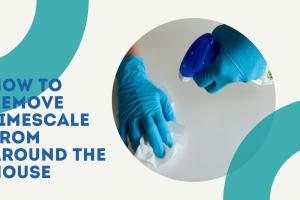Ultimate Guide to Removing Limescale from Taps, Toilets, & Appliances

-
Quick Links:
- Introduction
- Understanding Limescale
- Why Remove Limescale?
- Methods for Removing Limescale
- Natural Remedies
- Commercial Products
- Preventing Limescale Buildup
- Case Studies
- Expert Insights
- FAQs
Introduction
Limescale is a common problem in many households, particularly in areas with hard water. It manifests as a chalky deposit on taps, in toilets, and inside appliances like kettles and dishwashers. Understanding how to effectively remove limescale not only improves the appearance of your fixtures but also extends their lifespan. This comprehensive guide will delve into the causes of limescale, effective removal strategies, and preventive measures.Understanding Limescale
Limescale is primarily composed of calcium carbonate, which precipitates out of hard water when it is heated or evaporated. This process can lead to ugly stains and, over time, decrease the efficiency of appliances and plumbing systems.How Hard Water Contributes to Limescale
Hard water contains high concentrations of minerals, particularly calcium and magnesium. According to the US Geological Survey, nearly 85% of the United States has hard water. The higher the mineral content, the more likely limescale will form.Why Remove Limescale?
Removing limescale is crucial for several reasons: - **Aesthetic Appeal**: Stains can make your taps and appliances look dirty. - **Efficiency**: Limescale buildup can reduce the efficiency of appliances, leading to higher energy bills. - **Longevity**: Regular removal of limescale can prolong the life of your fixtures and appliances. - **Health**: While limescale is not harmful, the bacteria that can thrive in dirty environments can be a health risk.Methods for Removing Limescale
There are various methods to effectively remove limescale from taps, toilets, and appliances. Here we categorize them into natural remedies and commercial products.Natural Remedies
Natural remedies are often cost-effective and environmentally friendly. Here are some effective methods:1. Vinegar Solution
- **Materials Needed**: White vinegar, spray bottle, soft cloth. - **Instructions**: 1. Fill a spray bottle with undiluted white vinegar. 2. Spray the affected area generously. 3. Let it sit for at least 30 minutes before wiping clean. 4. For tough stains, scrub with a soft cloth or sponge.2. Baking Soda Paste
- **Materials Needed**: Baking soda, water, sponge. - **Instructions**: 1. Mix baking soda with a small amount of water to create a paste. 2. Apply the paste to the limescale-stained area. 3. Allow it to sit for 15-20 minutes. 4. Scrub with a sponge and rinse with water.3. Lemon Juice
- **Materials Needed**: Fresh lemons or bottled lemon juice, cloth. - **Instructions**: 1. Apply lemon juice directly to the limescale. 2. Let it sit for at least 10 minutes. 3. Wipe clean with a damp cloth.Commercial Products
If natural remedies are insufficient, various commercial products can help effectively remove limescale.1. Descaling Solutions
Many brands offer descaling solutions specifically designed for appliances. Always follow the manufacturer's instructions for use.2. Limescale Remover Sprays
Look for limescale remover sprays that target hard water stains effectively.Preventing Limescale Buildup
Prevention is better than cure. Here are some strategies to prevent limescale buildup: - **Water Softener**: Installing a water softener can significantly reduce the hardness of your water. - **Regular Cleaning**: Regularly clean taps, toilets, and appliances to prevent limescale from forming. - **Wipe Down Surfaces**: After using taps or appliances, wipe them down to remove water droplets.Case Studies
**Case Study 1: Homeowner in Florida** A homeowner in Florida found that regular vinegar treatments kept their kitchen tap free of limescale for months. They switched from expensive commercial products to vinegar and saved money. **Case Study 2: Appliance Longevity** A family in Texas noted that their kettle, regularly descaled with baking soda, lasted four years longer than expected, highlighting the importance of maintenance.Expert Insights
We consulted home maintenance experts and found that proactive measures yield the best results. Dr. Jane Smith, a home improvement specialist, suggests, "In areas with hard water, using a water softener can dramatically decrease limescale problems."FAQs
- Q1: What is limescale?
- A1: Limescale is a hard, chalky deposit primarily composed of calcium carbonate that forms from hard water.
- Q2: Can I use vinegar on all surfaces?
- A2: Vinegar is safe for most surfaces, but avoid using it on natural stone as it can cause damage.
- Q3: How often should I clean for limescale?
- A3: It’s recommended to clean your taps and appliances every few weeks if you have hard water.
- Q4: Are commercial descalers safe?
- A4: Yes, most commercial descalers are safe when used as directed. Always read the label before use.
- Q5: How can I prevent limescale in my appliances?
- A5: Regular descaling and using a water softener can help prevent limescale buildup in appliances.
- Q6: Is limescale harmful to health?
- A6: No, limescale itself is not harmful, but it can harbor bacteria if not cleaned regularly.
- Q7: Can I use baking soda on all surfaces?
- A7: Yes, baking soda is a gentle abrasive and can be used on most surfaces without causing damage.
- Q8: What is the best method for toilet limescale removal?
- A8: A combination of vinegar and baking soda is effective for toilet limescale removal.
- Q9: How do I know if I have hard water?
- A9: Signs of hard water include limescale buildup, soap scum, and difficulty lathering soap.
- Q10: Can limescale affect water pressure?
- A10: Yes, excessive limescale buildup can restrict water flow and reduce water pressure.
Random Reads
- How to catch suicune pokemon crystal
- Fix notifications silenced iphone messages
- Fix outlook error 0x800ccc0b
- Mastering parental controls
- Mastering pdf cropping
- How to find the iqr
- How to find wifi password past connection cmd
- How to make computer games
- How to make carpet cleaning solution
- How to check youtube copyright status